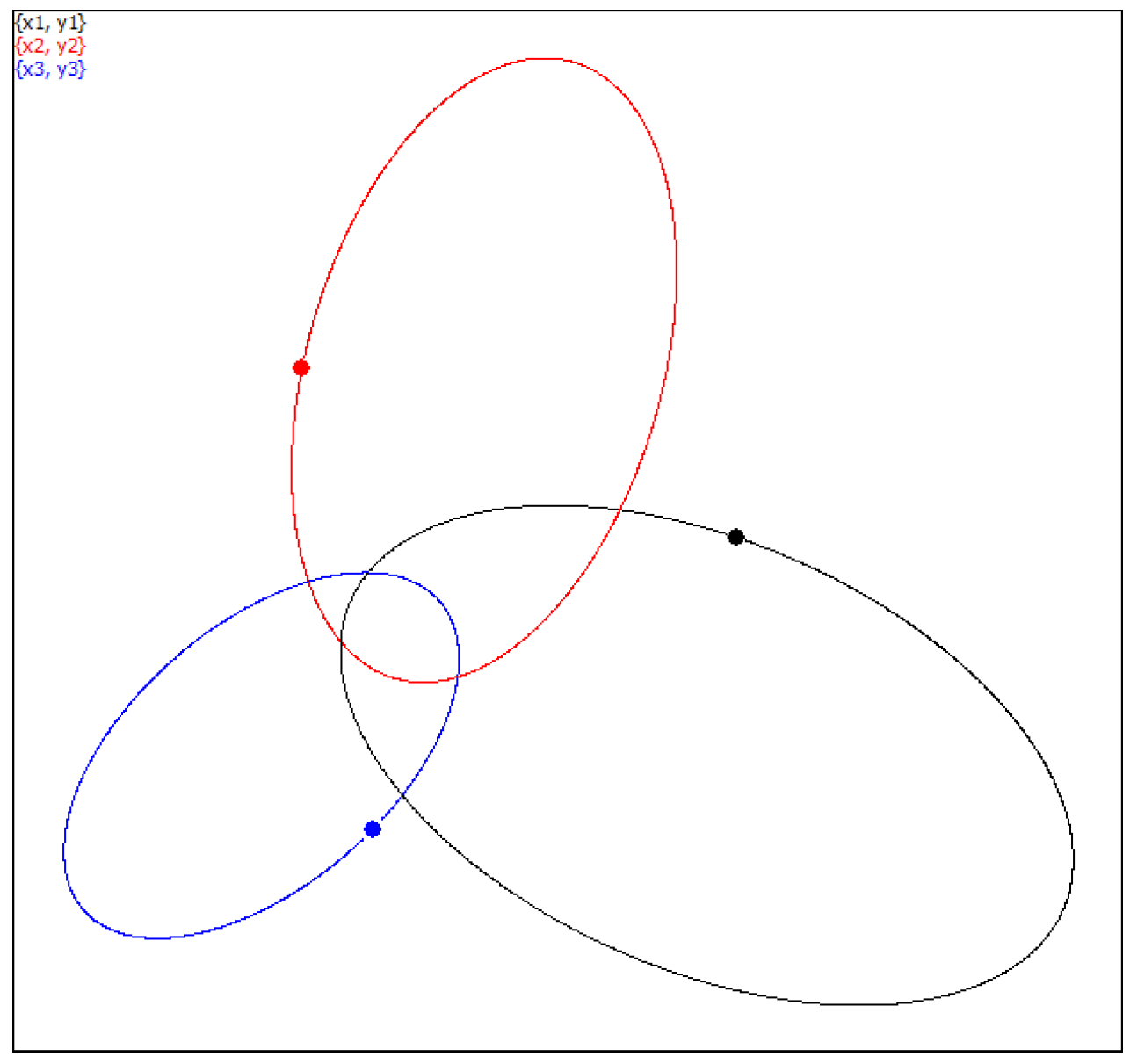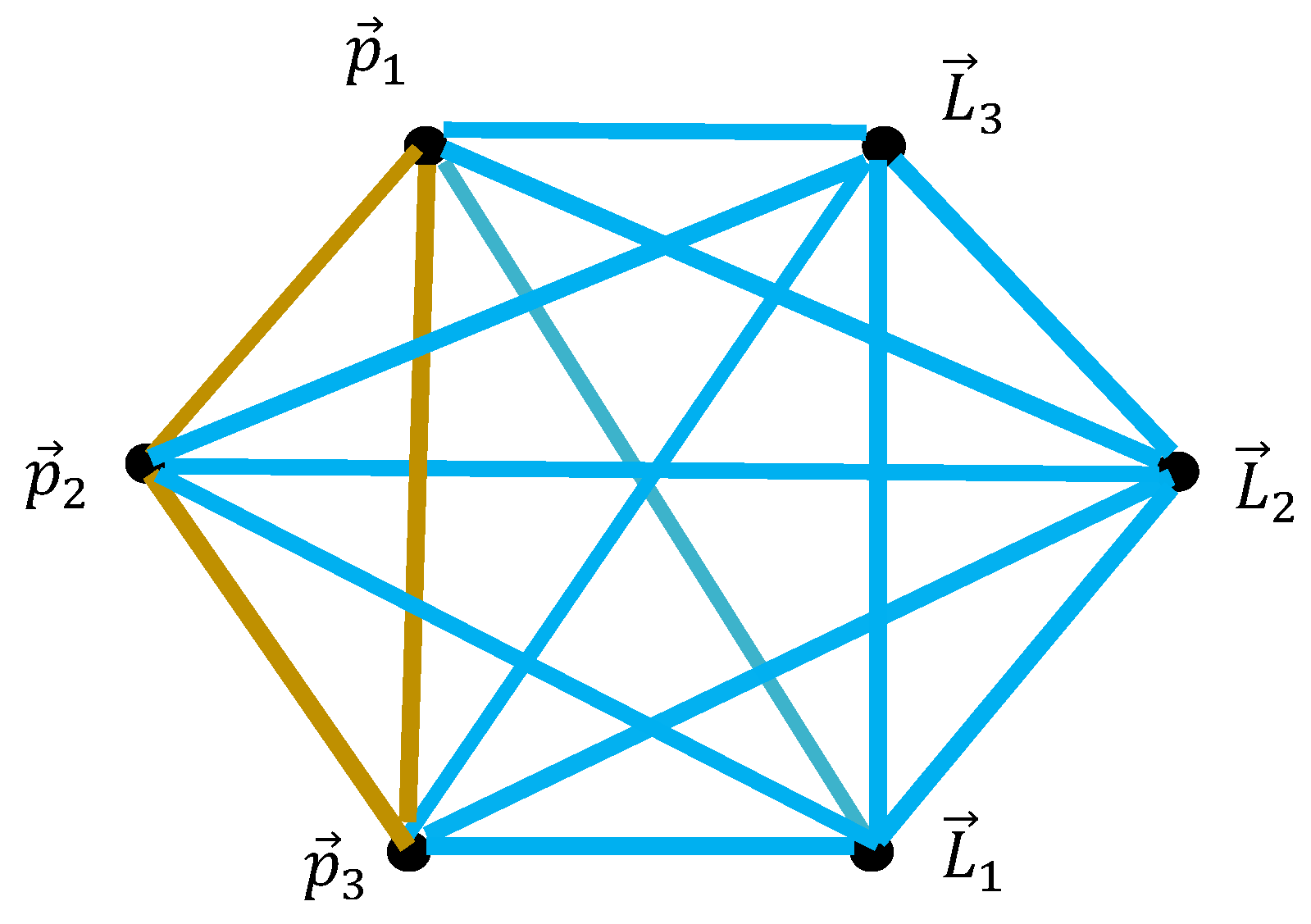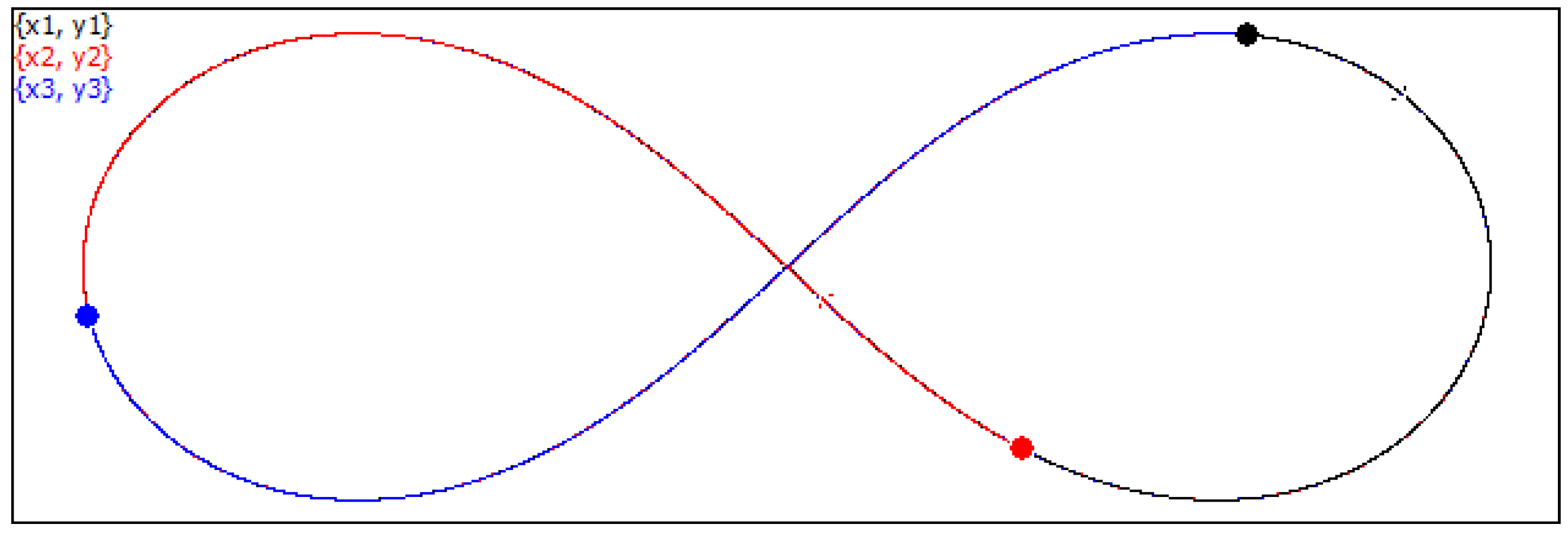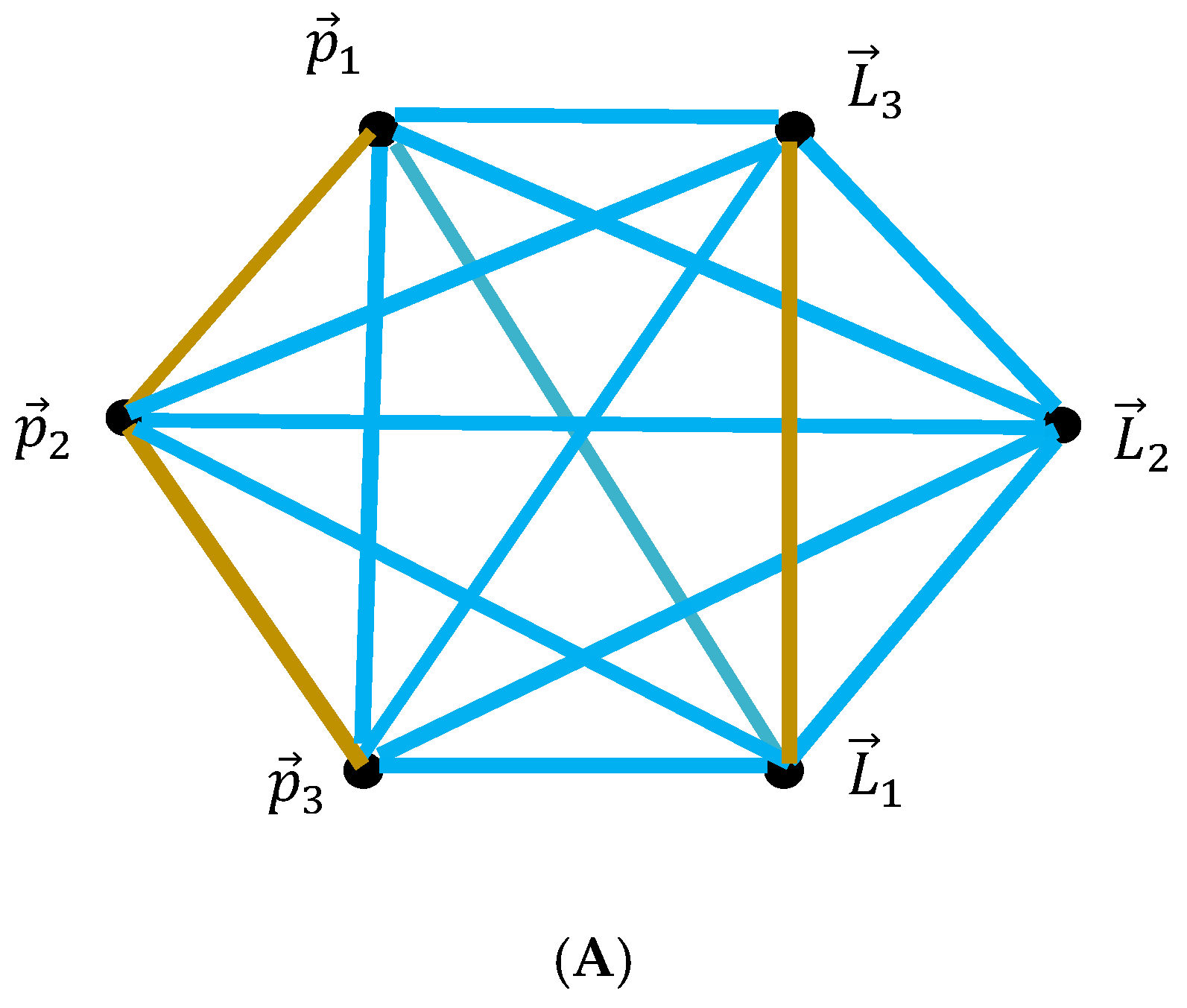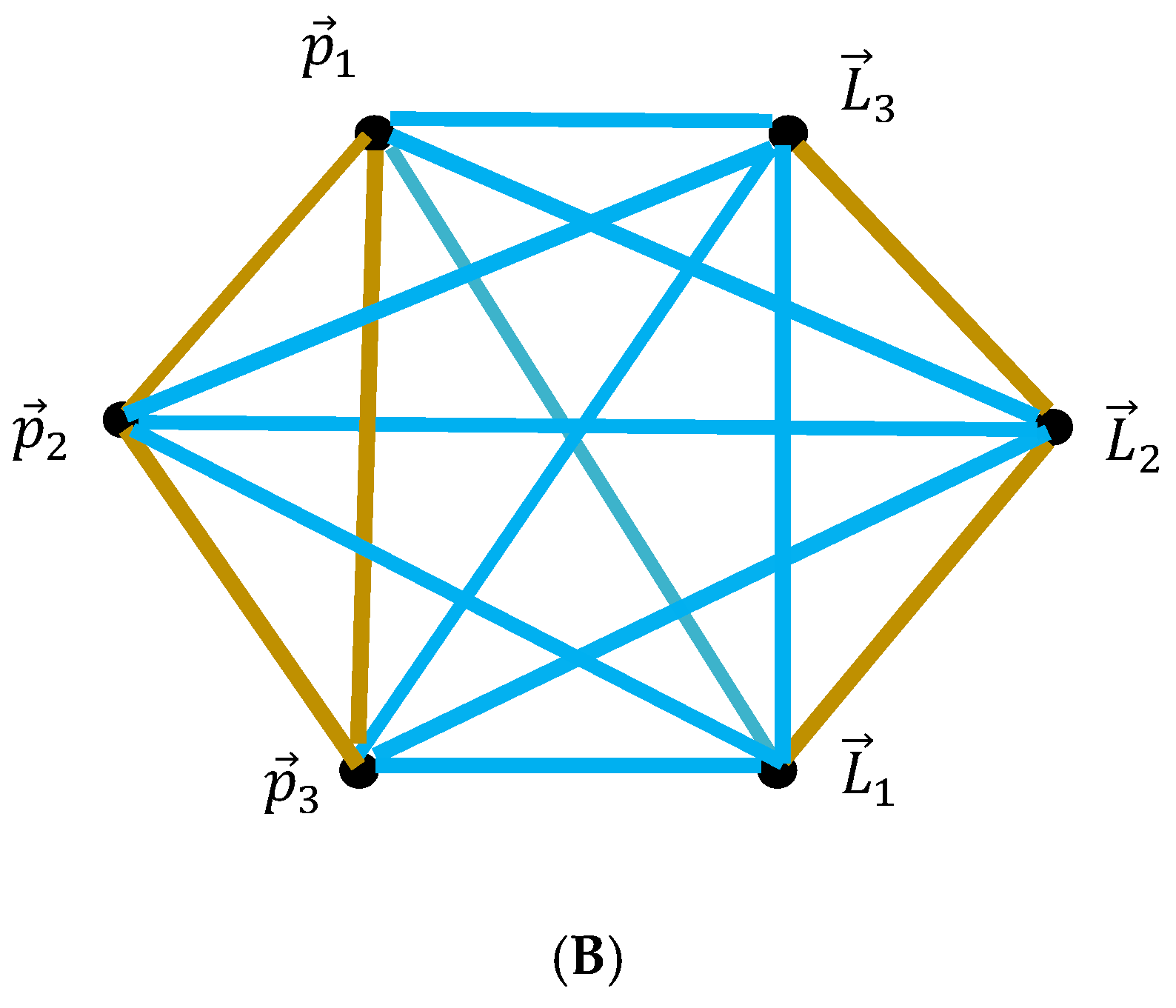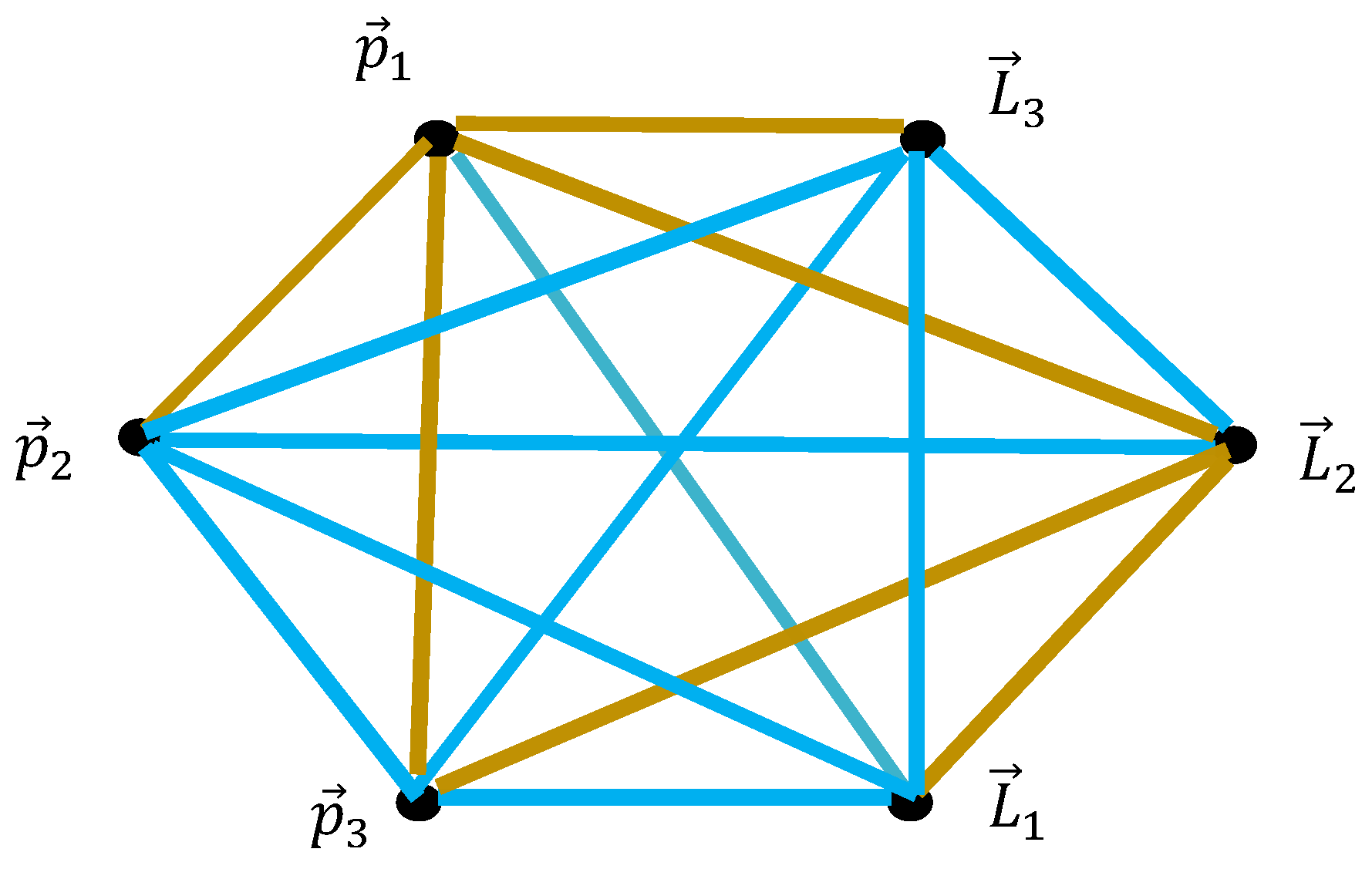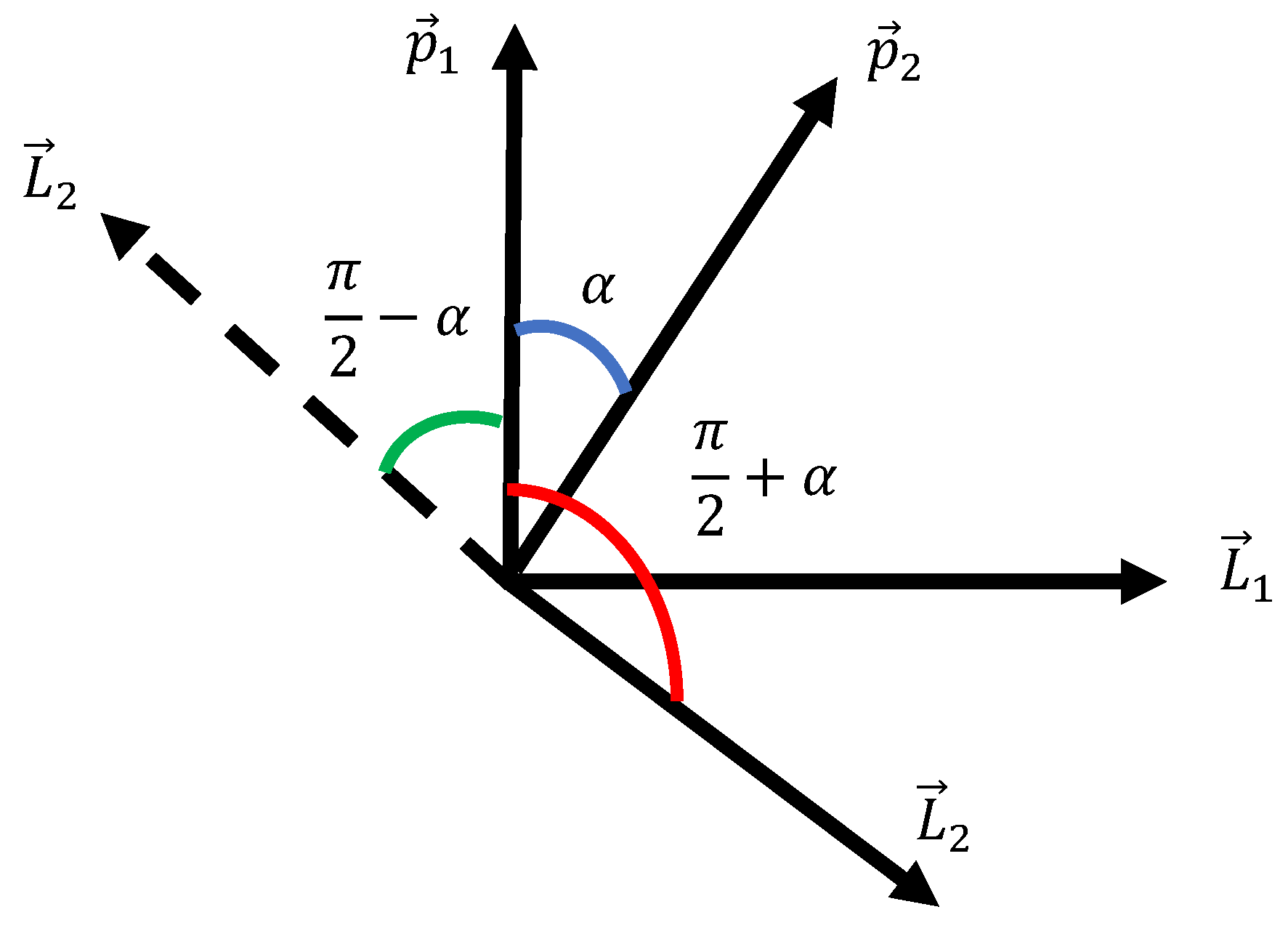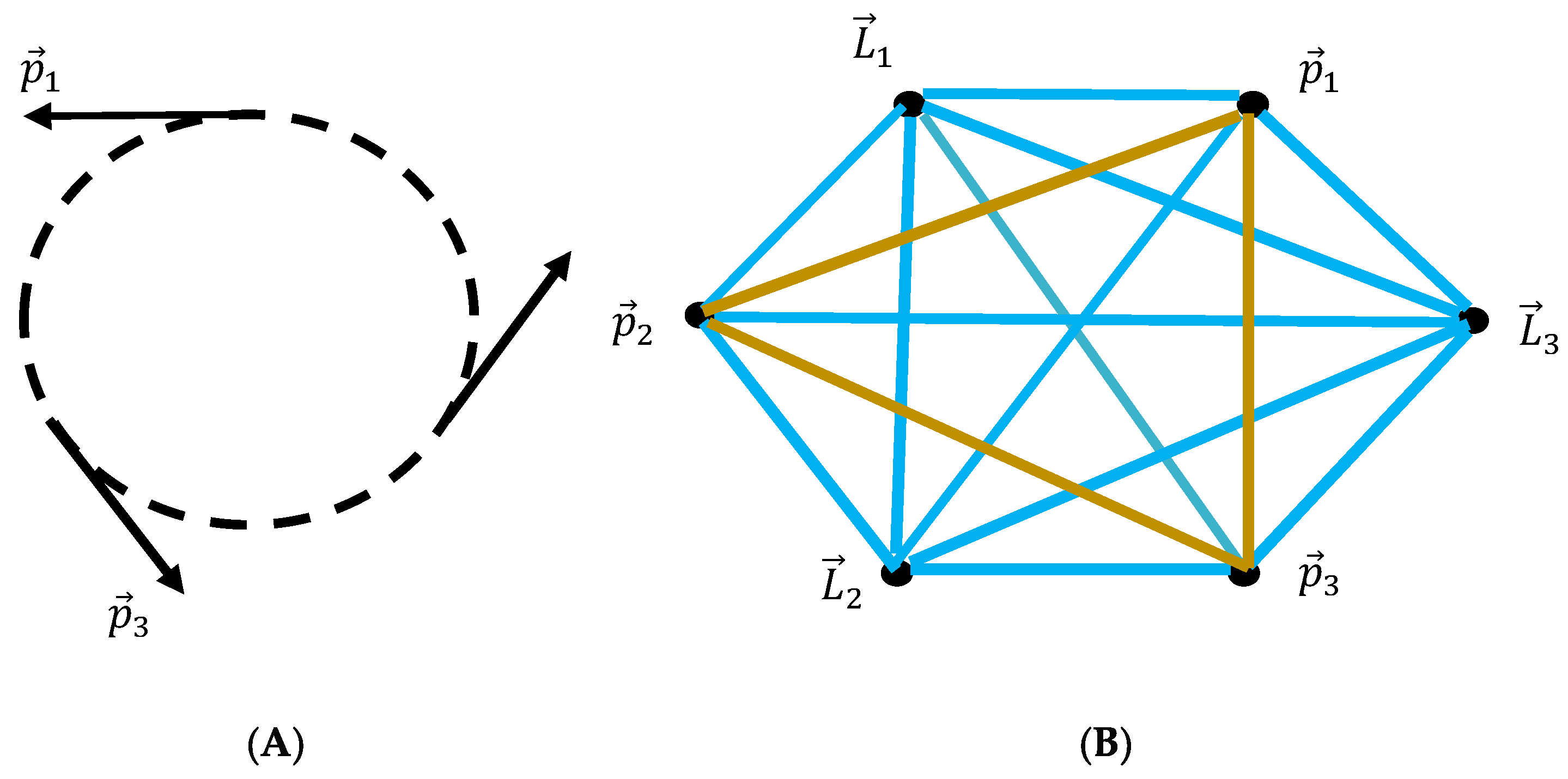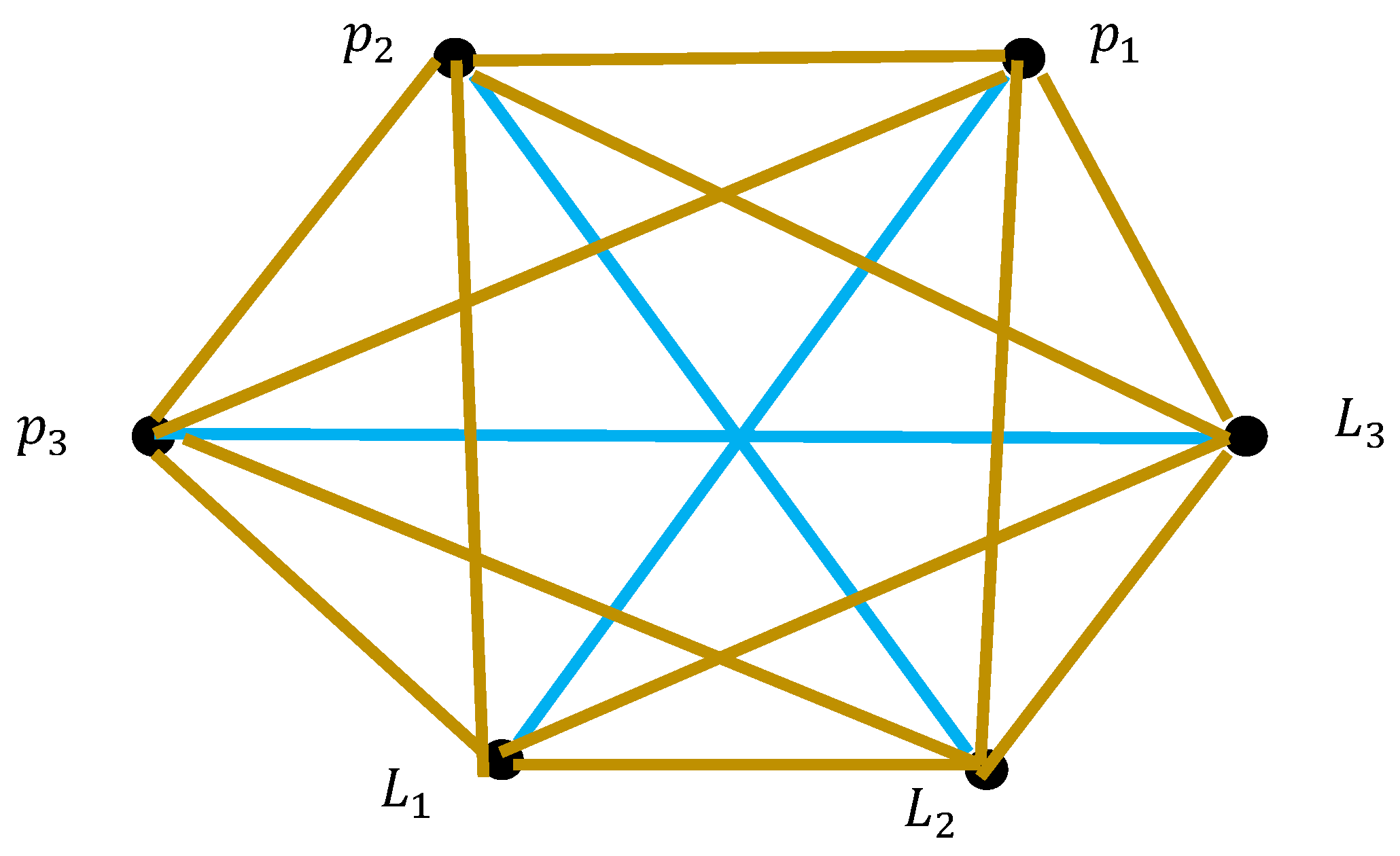2.1. Ramsey Momenta Graph Emerging from the Motion of the Three-Body System
Consider the general three-body problem. We address motion of three point particles
. which interact via an arbitrary potential. The momenta of the particles are denoted
; the angular momenta of the particles are labeled
. We make a snapshot of the particles’ motion made in an arbitrary frame. This snapshot gives rise to the bi-colored, complete graph, built according to the mathematical procedure, introduced below. The linear and angular momenta of the particles serve as the vertices of the graph. The vertices are connected with the colored links. The colors of the links are established, as follows. The vertices are connected with the turquoise link if Equation (1) takes place (see
Figure 1):
The vertices are connected with the mustard link, if Equation (2) is true:
This similar coloring procedure was already introduced for the graphs emerging from the motion of the particles [
14]. Now we extend the procedure for the analysis of the three-body problem.
It seems, at first glance, that the scalar products are physically senseless; however, we will demonstrate below that these scalar products enable the elegant generalization in the realm of the quantum relativistic theory, exploiting the Pauli–Lubansky pseudo-vectors.
Let us address some general combinatorics properties of the momenta graph. It is noteworthy that it is different from the conventional Ramsey complete bi-colored graph due to the fact that it is built of two distinguishable groups of vertices, namely and . Thus, no triangle (monochromatic or bi-chromatic) built of the edges is possible. Let us explain it: consider the edges and . The edge closing the triangle is necessarily , and it is built from the vectors of the angular momenta only. This is easily expanded to any of edges . Thus, no triangle (mono-chromatic or bi-chromatic) built only of the vertices is possible. Also, triangles built of mixed edges and only are impossible. This is easily checked.
Now let us discuss the coloring of the emerging momenta graph. Obviously, vertices linking vertices corresponding to the
and
are always connected with the turquoise link; indeed,
. This is true for 1D, 2D and 3D systems of vectors of linear and angular momenta and it remains correct in any frames. The sign of the scalar product of the linear and angular momenta of two different moving point masses is not fixed. It can be positive, negative, or zero depending on their relative positions and velocities. For linear momenta it is obvious; for the angular momenta it follows from Equation (3):
It is immediately recognized from Equation (3) that the sign of the scalar product of the angular momenta of two moving point masses can be positive, negative, or zero, depending on their relative positions and velocities. The sign of the scalar product
is also not fixed. This is illustrated with
Figure 2.
According to the Ramsey theorem, the bi-colored, complete Ramsey graph built of the six vertices will inevitably contain at least one mono-colored triangle. For the sake of brevity, we call the graph built according the aforementioned procedure the “momenta graph”. Thus, we demonstrate the following theorem:
Theorem 1. Consider arbitrary motion of six point particles. The particles interact via arbitrary interactions. Linear and angular momenta serve as the vertices of the graph. The vertices are connected with the turquoise link if take place. The vertices are connected with the mustard link if is true. The momenta graph will inevitably contain at least one mono-chromatic triangle.
Consider now the momenta graph shown in
Figure 1. It contains three turquoise triangles, namely:
,
,
, and one mustard triangle, namely:
.
Now we discuss the general properties of the momenta graph. First of all, we note that the Ramsey theorem does not define, what kind of mono-colored triangle will necessarily appear in the momenta graph [
5,
6,
7,
8,
9,
10,
11,
12,
13]. The second fact is very important: the coloring of the graph will remain the same when frames are rotated relatively to the origin of the frames. Indeed, scalar products given by Equations (1) and (2) are invariant relatively to the rotation of frames relatively to origin. The coloring of the graph remains untouched also for uniform scaling of vectors (i.e., the same scalar multiplication for vectors of linear and angular momenta and reflection of axes). Generally speaking, the coloring of the graph remains the same for general linear transformation of vectors
with a positive-definite matrix
A:
Let us demonstrate it:
and since
is also positive-definite, the sign is preserved. The same is true for the vectors of the angular momenta and mixed scalar products. Thus, we demonstrate that the coloring of the graph, depicted in
Figure 1, remains the same for general linear transformations of vectors with a positive-definite matrix
A. It is noteworthy that the coloring of the graph is not Lorentz invariant.
Now we consider the distribution of the colored links within the momenta graph. The total number of the links in this graph is
This number is built from the turquoise links, denoted
and the mustard links denoted
It is noteworthy that numbers are independent of the location of vectors/vertices within the graph; the order of the vectors/vertices of the linear and angular momenta is not important and is arbitrary. These numbers remain untouched under the rotation of the origin of the frames. However, they are sensitive to Galileo transformations.
Now we address the distribution of the mono-colored triangles within the momenta graph. For a given motion, changing the order of the vertices does not change the number or distribution of monochromatic triangles. When we permute the vertices, we are simply relabeling them. This does not affect the actual connections or edge colors, it just changes their names. Therefore, the structure of the graph remains the same, and so does the number and type of monochromatic triangles. Again, the number and type of monochromatic triangles is insensitive to rotation of frames but it is sensitive to Galileo transformations.
It should be emphasized that the aforementioned Theorem 1 remains true for any motion of three bodies, including the chaotic motion, i.e., deterministic but unpredictable behavior emerging in a three-body system [
1]. We mean the situation, when small differences in initial locations and velocities of bodies lead to vastly different outcomes over time, making long-term prediction practically impossible. The motion may be chaotic; however, at least one mono-colored triangle, predicted by Theorem 1, will be kept in any momenta graph. Thus, certain order will be necessarily recognized in any momenta graph. The quantification of orderliness of the graph will be discussed below. However, the coloring procedure defined by Equations (1) and (2), is sensitive to Galilean transformations [
14].
Now we introduce the notion of the “trivial motion graph”. The motion graph is defined as trivial when all of the scalar products given by Equations (1) and (2) are zero. Consider that in 3-dimensional space, the maximum number of mutually orthogonal vectors is three. Our graph is built of six vectors; thus, it is clear that the trivial motion graph is impossible. This is obviously also true for 2D and 1D motions of three bodies. The only exception is the degenerated case, when two or all of three particles are in rest. In this situation, all of the scalar products given by Equations (1) and (2) are zero. The graph is defined as “monochromatic” when all of the links are colored with the same color. The sketch depicted in
Figure 3 gives rise to the mono-chromatic motion graph. The sketch illustrates the circular, planar motion of three non-interacting bodies.
All of the angles between the linear momenta of the particles are acute. It is easily seen from Equation (1) that the entire motion graph is colored with turquoise.
2.4. Shannon Entropy of the Momenta Graphs
The Ramsey theorem states that the total chaos is impossible; ordered structures appear in the systems of a certain size, which is larger than a given value. Mono-chromatic triangles necessarily appear in the bi-colored complete graphs with the number of vertices larger than six. The very question is how the order emerging in the complete graph may be quantified. It may be quantified with the Shannon entropy [
15,
16,
17]. The Shannon entropy of the bi-colored Ramsey complete graph is labeled
S and it is introduced with Equation (7):
where
is the fraction of monochromatic
k-polygons/polygons with
k sides (whether turquoise or mustard ones) in the given complete graph [
15]. The sampling takes place over the entire set of monochromatic polygons, whatever their colors. The momenta graph shown in
Figure 1 contains three turquoise triangles and one mustard triangle (see
Section 2.1). The total number of monochromatic triangles is four. No monochromatic quadrangles, pentagons or hexagons are recognized in the graph. We calculate
What is the meaning of
S?
S is adequately interpreted as the average uncertainty to find the monochromatic polygon (whatever its color) within the set of monochromatic polygons appearing in the given complete bi-colored graph. The value of the Shannon entropy is exhaustively defined by the distribution of polygons in the given complete graph, and it is independent of the exact shapes of the polygons.
The Shannon measure of the graph may be introduced in an alternative way with a pair of Shannon entropies: namely,
and
, which are interpreted as follows:
is interpreted as an average uncertainty to find the turquoise polygon in the given graph,
is, in turn, an average uncertainty to find the mustard polygon in the same graph [
15]. In this case, sampling of polygons is carried out separately from the turquoise and mustard subsets of convex polygons. Thus, a pair of Shannon entropies
corresponds to any momenta graph. The pair of Shannon entropies is introduced as follows:
where
is the fraction of monochromatic turquoise (
-colored) convex polygons with
n α-sides or edges (turquoise edges), and
is the fraction of monochromatic convex mustard (
) polygons with
i -sides or edges (mustard edges) in a given complete graph. Sampling of polygons is carried out separately from the turquoise and mustard subsets of convex polygons. Thus, a pair of Shannon entropies
corresponds to any momenta graph. Only mono-colored triangles appear in the graph, thus
;
and we calculate
.
2.5. The Momenta Graph in the Center of Masses Frame
Consider an isolated system built of three interacting particles. We do not restrict the potentials of interaction. Now we analyze the momenta graph as it is seen in the center of mass frame. The scalar product of the total linear
and angular momenta
is given by Equation (10):
Equation (10) emerges from the fact that in the center of masses frame ( is not necessarily zero). The sum in Equation (10) equals zero in two cases:
- (i)
All of scalar products
This is the situation of the “trivial momenta graph” (see
Section 2.1).
- (ii)
Some of the scalar products are positive and some of them are negative.
We already mentioned that in 3-dimensional space, the maximum number of mutually orthogonal vectors is three and the trivial momenta graph is impossible. Thus, necessarily, we conclude that some of the scalar products are positive and some of them are negative and consequently the momenta graph in the center of masses frame is necessarily multi-colored. The only exception is the degenerated case when two or all of three particles are in rest in the center mass frame.
Thus, we demonstrate the following theorem:
Theorem 2. Consider an arbitrary motion of six point particles seen in the center of masses frame. The particles interact via arbitrary interactions. Linear and angular momenta serve as the vertices of the graph. The vertices are connected with the turquoise link if take place. The vertices are connected with the mustard link if is true. The momenta graph is necessarily multi-colored. The only exception is the degenerated case when two or all of three particles are in rest.
We illustrate the introduced graph approach with the graphs emerging from the Lagrange three-body problem [
1,
2,
3] in
Appendix A and the graph analysis of the recently discovered eight-figure orbits [
1,
18,
19,
20] in
Appendix B.
It is also instructive to build the stereographic projection of the momenta vectors. We propose to put the center of the stereographic sphere on the center mass of the three-body- system. Thus, in the isolated system the center of the stereographic sphere is in rest in a course of motion of the bodies. Hence, vectors of linear and angular momenta are analogous to poles in crystallography (poles are the directions normal to a specific crystallographic plane within a crystal lattice). Stereographic projection of the momenta vectors yields six points. These points serve now as the vertices of the graph. The coloring of the graph is prescribed with Equations (1) and (2). Thus, the complete, bi-colored, stereographic graph emerges. We label this graph as the stereographic, bi-colored graph. Stereographic projection preserves both directions and symmetry [
21]. Stereographic projection is a conformal mapping technique that accurately preserves angular relationships between momenta vectors [
21]. This means that the angles between momenta vectors are maintained in the two-dimensional projection. Symmetry of the system of momenta vectors will be kept within the stereographic momenta graph. Again, orderliness of the stereographic momenta graph may be quantified with the Shannon entropy
2.6. Quantum Field Generalization of the Momenta Graph
An elegant generalization of the suggested method for the quantum field theory is possible. Consider three particles possessing linear momenta four-vectors
,
and angular momenta tensors
. Consider that in relativity the angular momentum is already tensor, defined as follows:
where
is four-vector. Three vectors of linear momenta and three tensors of the angular momenta serve now as the vertices of the graph. Coloring of the momenta graph is now defined with the Pauli–Lubanski structures denoted
, indices
denote the number of the particles. The Pauli–Lubanski pseudo-vector is defined for quantum relativistic particles with Equation (12):
where
is the four-dimensional totally antisymmetric Levi-Civita symbol [
22]. The mass
m and spin
s of a particle are defined in terms of two quadratic invariants (Casimir operators of the Poincaré group) as follows [
22]:
In Equation (13) the natural units
are used. It is noteworthy that Equation (13) works for both bosons and fermions. We use Equation (12) for the elaboration of the momenta graph for three quantum relativistic particles. For the linear and angular momenta related to the same particle
the Pauli–Lubanski formula yields
For the angular and linear momenta related to different particles
we define the symmetrically shaped
Pauli–Lubanski-like structure as follows:
This Pauli–Lubanski-like structure, given by Equation (15), describes the total spin content of the two-particle system in a form that respects the exchange symmetry. The key properties of this structure are that it is invariant under Lorentz transformations and it is reduced to the standard Pauli–Lubanski vector when the system consists of a single particle
, given by Equation (14). Now we define the coloring of the graph as follows: we denote the links connecting the vertices numbered
and
with
. The link
is colored with turquoise, when
is timelike or null, namely Equation (16) is true.
The link
is colored with mustard, when
is space-like, namely Equation (17) holds
The possible momenta graph is illustrated with
Figure 5. The emerging graph is the complete, bi-colored, Ramsey graph. This graph should necessarily contain at least one mono-colored triangle Indeed, the triangles
,
,
,
,
are mono-colored, mustard. There are no mono-colored turquoise triangles in the graph.
Again, the Ramsey theory does not predict what kind of mono-colored triangles (mustard or turquoise) will necessarily appear in the graph. It should be emphasized that the coloring of the graph is Lorenz-covariant. Thus, the number of the turquoise links, denoted and the mustard links denoted are Lorentz invariant, and the mono-chromatic triangles appearing in the momenta graph are Lorentz invariant. Thus, we revealed the new kinds of Lorenz-invariant structures, inherent for momenta graph, built for quantum relativistic particles. Moreover, the symmetry of the momenta graph in this case is Lorenz invariant.
2.7. Three-Color Momenta Graphs and Their Properties
Bi-coloring of the momenta graphs defined with Equations (1) and (2) and Equations (16) and (17) is not unique. We introduce now three-colored graphs, as explained below. We start from the classical mechanics paradigm.
The vertices are connected with the turquoise link if Equation (18) takes place:
The vertices are connected with the mustard link, if Equation (19) is true:
The vertices are connected with the black link if Equation (20) takes place:
The coloring of this three-colored graph remains the same for general linear transformation of vectors supplied by Equations (4) and (5).
A similar three-colored procedure may be introduced for quantum relativistic particles with the Pauli–Lubanski-like structure defined by Equation (15). We define the coloring of the graph as follows: we denote the links connecting the vertices numbered
and
with
. The link
is colored with turquoise, when
is time-like; namely, Equation (16) is true.
The link is colored with mustard, when is space-like, i.e., Equation (22) holds .
The link
is colored with black, when
is null, i.e., Equation (22) holds:
The coloring and symmetry of the three-colored graph defined by Equations (21) and (22) is Lorentz invariant. The aforementioned three-colored graphs do not necessarily contain monochromatic triangle due to the fact that the Ramsey number is The same is true for the momenta graphs defined by Equations (18)–(20).
